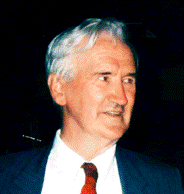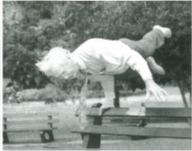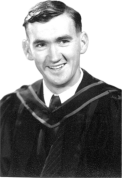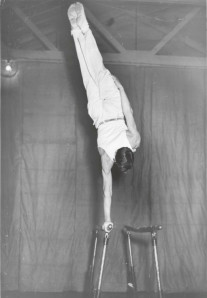Alex McNabb
(1930–2025)
MSc (NZ), BA (Camb), DSc (VUW), FRSNZ

Introduction and Personal Reflections
Dr Alex McNabb has a world-wide reputation as a mathematician. He was one of New Zealand’s leading applied mathematicians with a career that spanned over six decades. I knew Alex for 62 years. Our relationship began when, as a senior student in 1963, I was fortunate to have a summer-student internship in the Applied Mathematics Division of the Department of Scientific and Industrial Research (DSIR), housed in a small set of offices in Courtenay Place, Wellington. Alex was the senior applied mathematician, and we clicked immediately because we thought the same way. Our first project concerned modelling spontaneous combustion. This problem came to us from the partne r Division of Chemistry at DSIR and was motivated by the 1948 ignition of recently stored wet wool on the Wellington waterfront, which led to a fire that burnt down many buildings. Alex helped me to develop and analyze a model for this combustion. Indeed, I did a PhD on this topic and Alex extended his role to co- advising me in 1966-67, when my original supervisor returned to his native Scotland. To me, the model we developed was clear evidence that mathematics can be used to develop predictive algorithms for such phenomena.
r Division of Chemistry at DSIR and was motivated by the 1948 ignition of recently stored wet wool on the Wellington waterfront, which led to a fire that burnt down many buildings. Alex helped me to develop and analyze a model for this combustion. Indeed, I did a PhD on this topic and Alex extended his role to co- advising me in 1966-67, when my original supervisor returned to his native Scotland. To me, the model we developed was clear evidence that mathematics can be used to develop predictive algorithms for such phenomena.
This initial collaboration developed into a close working relationship that lasted for many decades and survived several moves in New Zealand, different affiliations, and even retirement. It was always a pleasure to collaborate with Alex. His input on any project was valuable; moreover, he was an exceedingly kind and considerate colleague who became a close friend. Upon his retirement from DSIR, I was happy to be able to continue work with him through external grants and research fellowships. In this modest way, I was able to help Alex and, perhaps more selfishly, continue a very fruitful partnership.
In modern parlance, Alex was a “team player”. Certainly, he could have “gone solo” and prospered, but he really valued his co-workers. He always ensured that all members of the team were fully acknowledged. He paid particular attention to emerging scientists and facilitated their development. He was quiet and unassuming in manner, and very kind to his co-workers. His leadership shines: it is reflected in the scientists that he mentored and his teams’ contributions to science.
Education
 Alex was born in 1930 in Nelson, the second of five children. From an early age, his academic talent was recognized. He attended Nelson College, where he became dux. He then went to the University of Canterbury, where he graduated with first-class honours. He left Canterbury with MSc and began employment at the DSIR. Soon, however, he was back at university. His talent was again recognized: he was awarded a scholarship to the University of Cambridge. He went to Emmanuel College, Cambridge, where he studied mathematics and earned a BA in 1957. He then returned to New Zealand to resume his post at DSIR.
Alex was born in 1930 in Nelson, the second of five children. From an early age, his academic talent was recognized. He attended Nelson College, where he became dux. He then went to the University of Canterbury, where he graduated with first-class honours. He left Canterbury with MSc and began employment at the DSIR. Soon, however, he was back at university. His talent was again recognized: he was awarded a scholarship to the University of Cambridge. He went to Emmanuel College, Cambridge, where he studied mathematics and earned a BA in 1957. He then returned to New Zealand to resume his post at DSIR.
Professional Career
The DSIR Applied Mathematics Division (1952-1988)
Alex worked for the Applied Mathematics Laboratory (AML) from 1952 to 1988. Under the supervision of Bill Taylor, he was invited during the 1952-53 Christmas vacation to the DSIR Applied Mathematics Laboratory to work on the diffusion of preservatives into green timber. The results were written up in 1953 as AML Reprint 036. This experience motivated Alex, who later wrote: ”This “exercise did more for my mathematics education in three months than three years at university had done previously or managed to do in the next three years.’’ The next year Alex was invited back to AML as a graduate vacation student. He began full time employment at AML on 5 February 1954 as a mathematical physicist with the understanding that he could study overseas, on leave without pay. Alex used this opportunity to keep his connection with DSIR but broaden his education at Cambridge.
Upon returning to New Zealand Alex resumed his employment with the AMD which was renamed the Applied Mathematics Division in 1964. This was another fruitful period for his research. At DSIR, he rose to head the mathematical physics section. Alex stayed with the DSIR until his retirement in 1988, though he did take up another visiting research position at the University of Southern California from 1967 to 1969. Like his Cambridge years, he negotiated this with the DSIR as leave without pay .
Alex obviously enjoyed working at the Applied Mathematics Division, writing ``Over the years, I have visited a number of research groups in Australia, America and the United Kingdom, but nowhere have I found a mathematical physics group with such vital contacts with experimental groups in other disciplines.’’. Alex was pivotal in establishing many of these contacts.
Post Retirement
Alex retired from the DSIR, but like most mathematicians, he continued his work. Post retirement Alex accepted a few research fellowships. In 1988 he came to Massey University in Palmerston North as a research fellow. In 1998 he moved to Auckland to take up another fellowship at the University of Auckland. Alex also travelled to Australia for extended periods to do further work on problems from industry. A quick glance at Alex’s publication list shows that he was very productive post-retirement.
Scientific Achievements and Contributions
Research
Alex made many notable contributions to applied mathematics and also pure mathematics. Although he is primarily remembered as an applied mathematician, Alex was a pioneer in the theory of comparison theories for partial and ordinary differential equations. His research provided a framework for the theory of existence and uniqueness of solutions to differential equations. This work alone made Alex a “name” amongst researchers in the vast field of differential equations. Another notable contribution in pure mathematics was his work on the factorisation of operators. He wrote a series of papers on this topic and showed how to solve an equation in operator form by splitting it into a number of easily computable steps. Like most of his work, these results have both theoretical and practical significance.
In applied mathematics, Alex worked on a number of problems, including geothermal modelling, soil compaction, diffusion of heat and water in trees, iron ore reduction, ore forming processes, hydrogen embrittlement, deformation of fired ceramics, stability of railway engines, gymnastics, and radioactive transport at Mururoa atoll. His research often explained previously unknown behaviour, showing that disparate system behaviour could be understood and predicted using mathematics. Certainly, Alex chose fields that were relevant to modern industry. In this sense he helped foster New Zealand’s role in “maths in industry”. Many of Alex’s papers are elegant, and inspirational. He was particularly adept at identifying non-linearity in a system and quantifying its affect.
Several of Alex’s earlier modelling papers were controversial, but over the decades, have now become standard. For example, his paper explaining how large deposits of copper occur in the upper parts of geothermal fields, is now universally accepted. Similarly, his foundational work on geothermal models, has provided the basis for reliable resource assessments, which have been vital in developing New Zealand’s liquid-dominated geothermal fields.
In later years Alex continued working on problems from industry. For example, he studied the dynamics of top loading washing machines and showed that such machines will always have a wobble somewhere in their cycle. “You cannot get rid of it” he said,” it will always be there”. We (largely Alex) went about proving this and this led to the company focussing on front-loading models, where the axis of spin is horizontal as opposed to top loaders where the axis of spin is vertical. Alex did not ignore more theoretical problems. For instance, we injected stochasticity (quantified uncertainty) in a couple of projects leading to a concept called “mean action time”. This work was fundamental with many applications.
Service and Awards
Referee, Reviewer and Editor
Alex was a referee for many mathematical journals. He would find any error in an incorrect proof of a new theorem. He thoroughly checked every line of a submitted paper, and when he could not follow the argument, would often come into the seminar room, where a group of his colleagues would work with him on the proof on the blackboard, until the omitted steps were discovered. He also reviewed papers in mathematics and served on various editorial boards including the Journal of Mathematical Analysis and Applications.
Awards and Recognition
In recognition of Alex’s outstanding contributions to mathematics and science he was awarded a DSc by Victoria University of Wellington in 1971 and elected as a Fellow of the Royal Society of New Zealand in 1985. In 1987 he was awarded the DSIR Ministerial Award for Excellence in Science.
In addition to his awards, Alex was recognized by his mathematical peers in the form of two conference events dedicated to his work. In February 2000, to mark his 70th birthday, the “McNabb Symposium” was organized in Auckland. This was a two day symposium dedicated to his work that was attended by mathematicians from Australasia and North America. In 2019 a special session at the ANZIAM conference in Nelson (NZ) was organized to further celebrate.
Science Legacies
We touched on some of Alex’s contributions that have left footprints on science and mathematics. Here, however, we note a few more of his contributions. I have mentioned that Alex mentored me as a young mathematician. In fact, Alex played a pivotal role as mentor to many applied mathematicians. A key mantra of Alex was to validate mathematical models to data. Applied mathematicians benefited from Alex’s vast experience, which often enabled one to identify the key process in a system and thereby admitted an elegant system of equations to be developed to quantify the process. Alex gave this help freely and by this inspired another generation of mathematicians many of whom have risen to key roles in science and industry.
It is common that the reputation and legacies of a scientist (let alone a mathematician) are confined to a narrow band of researchers and students in specialized fields. This is not the case for Alex. I have mentioned his contribution that was instrumental in changing a company’s focus on top loading washing machines. This is but one example. In a 1985 science column by New Zealand writer Bob Brockie entitled “Stars outside our home”, Alex was publicly recognized for his fundamental contributions to metal fatigue among other things. Brockie wanted to alert his fellow New Zealanders that they were “among the world’s highfliers”.
More than Mathematics: Alex’s Life
Alex: The Family Man
Throughout his life and career family remained central to Alex. As noted, Alex began his career at DSIR in 1954 but then went to England to study at Cambridge. On his voyage home to New Zealand fate intervened: Alex met Maxine, a warm and outgoing young nurse. They soon married, settled in Porirua, and within seven years welcomed five children. Maxine adored children and was a devoted, loving mother.
Alex’s brilliance in applied mathematics and physics gained international recognition, leading to a three-year research appointment at the University of Southern California. The family made treasured memories in Pasadena, exploring Yosemite, the Grand Canyon and beyond, before returning to Wellington. In 1979, Alex and Maxine went their separate ways but remained united in their love for their children.
Alex continued his quiet dedication to work and sport. Through gymnastics coaching, he found love again. Yvonne was his perfect match. They married and built a strong and enduring partnership. Yvonne was always by his side, sharing life’s challenges and adventures. They shifted to Palmerston North and then to Auckland.
In later years, Alex and Yvonne moved to the Edmund Hillary Retirement Village in Auckland. Even in retirement, his curiosity never faded. He made new friends and inspired others with his gentle wisdom and gracious spirit.
Alex the Sportsman: Gymnastic Achievements
Alex was not only academically gifted but also a talented athlete.
While at Cambridge, he won the 1954 Inter-University Gymnastics Championship and, as team captain the following year, led his team to a strong runner-up finish. As a measure of his adroitness in gymnastics, he was invited by Swiss champion Josef Stolder to join the Swiss national team and offered citizenship. But Alex’s heart remained with his family and homeland, and he chose to return to New Zealand.
Back home, he continued to shine, winning five New Zealand national gymnastics titles between 1948 and 1962. He loved the sport deeply, and his passion extended beyond competition—he became a respected coach and honor ary lecturer, sharing his knowledge and inspiring others. Indeed, well into his retirement Alex could still do a handstand!
ary lecturer, sharing his knowledge and inspiring others. Indeed, well into his retirement Alex could still do a handstand!
In closing, I would like to say that Alex was a remarkable man who made lasting and substantial contributions to mathematics, science and gymnastics. His peer, Professor John Butcher, wrote for an introduction to his 70th birthday symposium that:
“There is something in the essence of Alex McNabb-ness that determines his style in all areas of his life. Mens acrobatica in corpore acrobatico — an acrobatic mind in an acrobatic body. “
His legacy lives on—not only in his achievements, but in the lives of all those he touched as a father, grandfather, great-grandfather, coach, friend and loving partner. Alex is survived by his wife Yvonne and children Anne, David, John, Elizabeth and Andrew.
List of Publications
Alex was a prolific writer. He authored numerous research papers and reports on mathematics, problems in industry, and science in general. In compiling a list of publications, we limited it to those papers in journals or proceedings that are publicly available. It is recognized that a lot of his contributions in industry were necessarily recorded as internal reports.
McNabb, A.; Taylor, W. B. (1953). Some Theory Relating to the Diffusion of Chemicals in Green Timber. N.Z.J.Sci.& Tech. B, 35 113 - 126.
McNabb, A.; Taylor, W. B. (1955). A Note on Some Theory Relating to the Diffusion of Chemicals in Green Timber.N.Z.J.Sci.& Tech. B, 36 No. 5, 533 - 536.
McNabb, A. (1960). A mathematical treatment of one-dimensional soil consolidation. Quarterly of Applied Mathematics, 17, 337–347.
McNabb, A. (1961). Strong comparison theorems for elliptic equations of second order. Journal of Mathematics and Mechanics, 10, 431–440.
McNabb, A. (1961). Comparison and existence theorems for multicomponent diffusion systems. Journal of Mathematical Analysis and Applications, 3, 133–144.
Drummond, J. E.; McNabb, A. (1962): On the Analysis of Surface Temperature Surveys. N.Z. J. of Geology and Geophysics, Vol. 5, 1, 3 - 17.
McNabb, A. (1962). On the flux of diffusing matter through boundaries. Proceedings of the American Mathematical Society, 13, 170–174.
McNabb, A. (1962). A note on the boundedness of solutions of linear parabolic equations. Proceedings of the American Mathematical Society, 13, 262–265.
McNabb, A. (1962). Notes on criteria for the stability of steady state solutions of parabolic equations. Journal of Mathematical Analysis and Applications, 4, 193–201.
McNabb, A.; Foster, P. K. (1963). A New Analysis of the Diffusion of Hydrogen in Iron and Ferritic Steels. Trans. of the Metallurgical Soc. of AIME, 227, 618 - 627.
Foster, P. K., McNabb, A.; Payne, C. M. (1965). On the rate of loss of Hydrogen from cylinders of iron and steel. Trans. of the Metallurgical Soc. of AIME, 233, 1022 - 1031.
McNabb, A. (1966). On Convection in a Porous Medium. Proceedings of the Second Australasian Conference on Hydraulics and Fluid Mechanics, University of Auckland 6th to 11th December, 1965 C161-C171.
Grant, M. A.; McNabb, A. (1967). The Discharge of a Long Slender Bore. N.Z. J. of Science, Vol. 10, No. 1, 115 - 123.
McNabb, A.; Duncan, M. E. (1967). Firing Deformation of Ceramic Bodies. The American Ceramic Soc. Bulletin, 46, No. 5, 514 - 520.
McNabb, A. (1967). Partial Steiner symmetrization and some conduction problems. Journal of Mathematical Analysis and Applications, 17, 221–227.
McNabb, A.; Wolf, M. B. (1968). Time-Dependent Behaviour for a Countercurrent Dialyzer. Mathematical Biosciences, 3, No. 3/4, 295 - 306.
Kaplan, S., McNabb, A.; Wolf, M. B. (1968). Input-Output Relations for a Countercurrent Dialyzer by the Method of Invariant Imbedding. Mathematical Biosciences 3, No. 3/4, 289 - 293.
Buell, J., Kagiwada, H., Kalaba, R. E., McNabb, A.; Schumitzky, A. (1968). Computation of the resolvent for the auxiliary equation of radiative transfer. J. Quant. Spectrosc. Radiat. Transfer, 8 1481 - 1489.
Kaplan, S. McNabb, A. Trujillo, D.; Siemsen, J. K. 1969: The inverse problem of radioisotope diagnosis: A computational method determining the location and size of tumors. Mathematical Biosciences, 5, 39 - 55.
McNabb, A.; Schumitzky, A. (1970). Factorization of operators. II. A nonlinear Volterra method for numerical solution of linear Fredholm equations. Journal of Computer System Sciences, 4, 103–128.
McNabb, A.; Schumitzky, A. (1970). Factorization of operators. III. Initial value methods for linear two-point boundary value problems. Journal of Mathematical Analysis and Applications, 31, 391–405.
McNabb, A.; Schumitzky, A. (1972). Factorization of operators. I. Algebraic theory and examples. Journal of Functional Analysis, 9, 262–295.
McNabb, A. (1972). Initial value method for linear boundary value problems. Journal of Mathematical Analysis and Applications, 39, 495–526.
Drummond, J. E.; McNabb, A. (1972). The Heating of Cold-water Intrusions in a Geothermal Field. N.Z. J. of Science, 15, No. 4, 665 - 672.
McNabb, A.; Schumitzky, A. (1973). Factorization and imbedding for general linear boundary value problems. Journal of Differential Equations, 14, 518–546.
McNabb, A.; Schumitzky, A. (1974). An initial value theory for linear causal boundary value problems. Journal of Differential Equations, 15, 322–349.
McNabb, A. (1975). Asymptotic behaviour of solutions of diffusion equations. Journal of Mathematical Analysis and Applications, 51, 219–222.
McNabb, A. (1975). Asymptotic behavior of solutions of a Stefan problem. Journal of Mathematical Analysis and Applications, 51, 633–642.
McNabb, A.; Schumitzky, A. (1975). Factorization of Fredholm operators on analytic functions. Academic Press, New York-London.
McNabb, A., McAdam,; Bradford, E. (1975). : A Coupled Diffusion Model for the Reduction of Agglomerates of Iron Oxide Granules. Metallurgical Transactions B, 6B, 593 - 600.
McNabb, A.; Anderssen, R. S.; Lapwood, E. R. (1976). Asymptotic behavior of the eigenvalues of a Sturm-Liouville system with discontinuous coefficients. Journal of Mathematical Analysis and Applications, 54, 741–751.
Sutton, F. M.; McNabb, A. (1977). Boiling curves at Broadlands geothermal field, New Zealand. N.Z. J. of Science, 20, 333 - 337.
McNabb, A.; Heath, J. M. (1977). Approximate equations for the diffusion of heat and moisture in wool. N.Z. J.of Science, 20, 11 - 18.
McNabb, A.; Schumitzky, A. (1978). Factorization of Fredholm operators on analytic functions. Journal of Functional Analysis, 29, 336–374.
Henley, R. W., & McNabb, A. (1978). Magmatic Vapour Plumes and Ground-Water Interaction in Porphyry Copper Emplacement. Economic Geology, 73, No. 1, 1 - 20.
McNabb, A.; Weir, G. J. (1980). A Solution of Poisson's Equation. N.Z. J. of Science, 23 185 - 187.
McNabb, A.; Weir, G. J. (1980). Heat losses from an insulated pipe. Journal of Mathematical Analysis and Applications, 77, 270–277.
McNabb, A. (1981). The asymptotic response of a calorimeter. Journal of the Australian Mathematical Society, Series B, 22, 348–352.
Fradkin, L., McNabb, A.; Sorrey, M. (1981). On Identification and Validation of some Geothermal Models. Water Resources Research, 17, No. 4, 929 - 936.
Fradkin, L.; McNabb, A. (1982). System Identification in Geothermal Modelling. Proceedings of Pacific Geothermal Conference 1982 (4th. New Zealand Geothermal Workshop) part 2.
Stakgold, I.; McNabb, A. (1984). Conversion estimates for gas-solid reactions. Mathematical Modelling, 5, 325–330.
Stakgold, I.; McNabb, A. (1984). Conversion estimates for gas-solid reactions. Pergamon Press, Oxford.
McNabb, A. (1985). An uncoupling procedure for a class of coupled linear partial differential equations. Journal of the Australian Mathematical Society, Series B, 26, 503–516.
McNabb, A.; Fradkin, L. J. (1985). A note on the Cauchy problem for differential-difference equations. Journal of Mathematical Analysis and Applications, 109, 230–232.
McNabb, A. (1986). Comparison theorems for differential equations. Journal of Mathematical Analysis and Applications, 119, 417–428.
McNabb, A. (1986). The kernel of operators uncoupling systems of linear partial differential equations. Applied Analysis, 23, 29–41.
McNabb, A.; Weir, G. (1988). Comparison theorems for ordinary differential equations with general boundary conditions. Journal of Mathematical Analysis and Applications, 130, 144–154.
McNabb, A.; Weir, G. (1988). Comparison theorems for causal functional-differential equations. Proceedings of the American Mathematical Society, 104, 449–452.
Bass, L.; McNabb, A. (1988). Flux Ratio Theorems for Nonlinear Membrane Transport under Nonstationary Conditions. J.Theor. Biol. 133, 185 - 191.
McAdam, G. D., McNabb, A.; Bradford, E. (1988). Experimental Support for a Coupled Diffusion Model of Iron Oxide Reduction. J. of Iron and Steel Making, 15, No. 5, 219 - 227.
Hill, J. M.; McNabb, A. (1989). On the problem of uncoupling systems of linear differential equations. Journal of the Australian Mathematical Society, Series B, 30, 483–501.
McNabb, A.; Wake, G. C. (1989). Some explicit solutions of −ΔW=1 with Robin boundary data. Occasional Publications in Mathematics and Statistics, 17, Massey University.
McNabb, A.; Bass, L. (1989). Flux-ratio theorems for nonlinear equations of generalized diffusion. IMA Journal of Applied Mathematics, 43, 1–9.
Burnell, J. G., McNabb, A., Weir, G. J.; Young, R. (1989). Two-phase Boundary Layer Formation in a Semi-Infinite Porous Slab. Transport in Porous Media. 4, 395 - 420.
Burnell, J. G., Kissling, W., McGuinness, M., McNabb, A., Weir, G. J., White, S.; Young, R. (1989). Two-Phase Flow Studies. Proceedings 11th. N.Z. Geothermal Workshop 1989 pp.241-246.
McNabb, A.; Bass, L. (1990). Flux theorems for linear multicomponent diffusion. IMA Journal of Applied Mathematics, 44, 155–161.
Hill, J. M.; McNabb, A. (1990). On Dankwerts' transformation for two variable coupled systems. Bulletin of the Australian Mathematical Society, 41, 355–369.
McNabb, A.; Wake, G. C.; Hossain, M. M.; Lambourne, R. D. (1990). Transition times between steady-states for heat conduction. Part I. Occasional Publications in Mathematics and Statistics, 20, Massey University.
McNabb, A.; Wake, G. C.; Hossain, M. M.; Lambourne, R. D. (1990). Transition times between steady-states for heat conduction. Part II. Occasional Publications in Mathematics and Statistics, 21, Massey University.
McNabb, A.; Jones, O. (1990). Transformations of singular systems of linear partial differential equations. Applied Analysis, 39, 227–242.
McNabb, A.; Bass, L. (1991). A diffusion-reaction model for the cellular uptake of protein-bound ligands. SIAM Journal on Applied Mathematics, 51, 124–149.
McNabb, A.; Wake, G. C. (1991). Heat conduction and finite measures for transition times between steady states. IMA Journal of Applied Mathematics, 47, 193–206.
McNabb, A.; Wake, G. C.; Lambourne, R. D.; Anderssen, R. S. (1991). Theoretical derivation of rules-of-thumb for freezing times. Inverse Problems, 7, 633–642.
Parshotam, A., Wake, G. C., McNabb, A.; Bhamidimarri, R. (1991). Analytical bounds to the solutions of a model of a Fluidised bed biofilm reactor (FBBR).Chemeca 91: Proceedings of the 19th Australasian Chemical Engineering Conference Newcastle, Australia Sept 1991. 1, 499 - 506.
McNabb, A.; Parshotam, A.; Wake, G. (1992). Outputs and time lags for linear bioreactors. Mathematical and Computer Modelling, 16, 109–120.
McNabb, A.; Anderssen, R. S. (1992). The freezing time for pseudo-ellipsoids. Proceedings Centre for Mathematical Applications, Australian National University, 30, 184–195.
McNabb, A. (1993). A generalized Danckwerts transformation. European Journal of Applied Mathematics, 4, 189–204.
Keady, G.; McNabb, A. (1993). Functions with constant Laplacian satisfying homogeneous Robin boundary conditions. IMA Journal of Applied Mathematics, 50, 205–224.
Parshotam, A.; McNabb, A.; Wake, G. (1993). Comparison theorems for coupled reaction-diffusion equations in chemical reactor analysis. Journal of Mathematical Analysis and Applications, 178, 196–220.
Keady, G.; McNabb, A. (1993). The elastic torsion problem: solutions in convex domains. New Zealand Journal of Mathematics, 22, 43–64.
McNabb, A. (1993). Mean action times, time lags, and mean first passage times for some diffusion problems. Mathematical and Computer Modelling, 18, 123–129.
McKibbin, R.; McNabb, A. (1993). Modelling the phase boundaries and properties of the system H2O-NaCl at high temperatures and pressures. Proceedings of the 15th New Zealand Geothermal Workshop 1993, University of Auckland, pp. 267-273.
McNabb, A., White, S.P.; McKibbin, R. (1993). Brine circulation and hot-plate formation. Proceedings of the 15th New Zealand Geothermal Workshop 1993, University of Auckland, pp. 275-277.
McNabb, A.; Bass, L. (1994). Moment expressions for some diffusion-reaction problems. Computers & Mathematics with Applications, 27, 163–168.
McNabb, A.; Keady, G. (1994). Diffusion and the torsion parameter. Journal of the Australian Mathematical Society, Series B, 35, 289–301.
Bracken A. J., McNabb A.; Suzuki M. (1994).: Usings Flux Ratio Theorem for Nonlinear Diffusive Transport with Chemical Interactions. ’94 KACC Proc. 9th Korea Automatic Control Conf., 747-752.
McNabb A., Bass L.; Suzuki M. (1995). Using Flux Ratio Theorems for Albumin Enhanced Fatty Acid Fluxes across a Lipid Water Interface. Applied Maths. Letters, 8, No. 3, pp. 63-68.
McKibbin, R.; McNabb, A. (1995). Mathematical Modelling of non-condensible gases in hot dense brines: The System H2O –NaCl-CO2 Proceedings of the 17th New Zealand Geothermal Workshop 1995, University of Auckland.
McNabb, A. (1995). Block-size determination in fractured porous media. IMA Journal of Applied Mathematics, 55, 269–279.
Levine, H.; McNabb, A. (1996). Some unsteady diffusion and absorption problems. IMA Journal of Applied Mathematics, 56, 1–19.
Suzuki, M.; McNabb, A.; Bracken, A. J. (1996). Membrane diffusion and flux response. Applied Mathematics Letters, 9, 35–40.
McNabb, A.; Wake, G. C.; Van Dyk, A. K.; Gooch, C. (1996). A diffusion-reaction model for corrosion of zinc coated steel under polymer paint films. World Scientific Publishing Co.
Suzuki, M.; McNabb, A.; Bracken, A. J. (1996). A boundary flux property for a general nonlinear diffusion reaction system. Society for Industrial and Applied Mathematics (SIAM), Philadelphia, PA, 235–239.
Wilcock William S. D.; McNabb A..(1996). :Estimates of Crustal Permeability on the Endeavour Segment of the Juan de Fuca Mid-ocean Ridge. Earth and Planetary Science Letters, 138, 83-91.
McNabb, A.; Please, C. P.; McElwain, D. L. S. (1999). Spontaneous combustion in coal pillars: buoyancy and oxygen starvation. Mathematics in Engineering, Industry, 7, 283–300.
McKibbin R.; McNabb A. (1999). Deep Hydrothermal Systems: Mathematical Modeling of Hot Dense Brines Containing Noncondensible Gases. Journal of porous Media, 2(1), pp. 107-126.
McNabb, A.; Suzuki, M.; Bracken, A. J. (2001). A flux ratio theorem for multicomponent linear diffusion equations. Applied Mathematics Letters, 14, 123–129.
McNabb, A. (2009). A conceptual model for the origins of geothermal and volcanic activity in the North Island of New Zealand. ANZIAM Journal, 50, 421–425.
Acknowledgements
I would like to express my thanks to Alex’s family and to the mathematicians who have collaborated with me in the writing of this tribute to the life and work of our friend and colleague Alex McNabb.
Emeritus Professor Graeme Wake PhD, DSc (VUW), FRSNZ, FNZMS
July 2025
